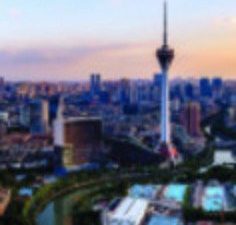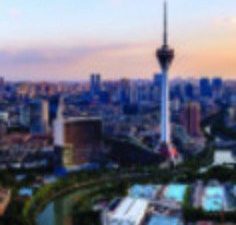Boom Town
December 31, 2017

The drive into Chengdu from busy Shuangliu International Airport seems to follow the usual pattern found in modern Chinese cities, along a wide, well-built expressway lined with car dealers ranging from Mazda and Honda to Mercedes, Maserati and Bentley. The city skyline appears up ahead, a typical forest of soaring towers…
But then we turn north toward an even larger urban sprawl and I realize that that was merely part of the Tianfu New Area that has grown so fast in the last few years. This planned 600-square-mile city – under Chengdu’s jurisdiction – will comprise seven zones focusing on manufacturing, high-tech, innovation and R&D industries, as well as scenic water and mountain areas to make it appealing as a livable new urban center.
A bustling city with more than 4,000 years of history as the focal point of the fertile Sichuan Basin, Chengdu has seen its share of change over the ebb and flow of millennia, but never on a monumental scale like this. “Three years ago I came here and the only international hotels were Sofitel Wanda and the Shangri-La,” – there was a Sheraton too – “but look at it now, see how many hotels there are,” says Khan Sung, general manager of the brand-new JW Marriott Chengdu.
The old downtown district north of the Jinjiang River is still the cultural and business hub, but four subway lines now transport its population of 7.8 million out to sprawling suburbs and secondary urban centers, while Chengdu’s population over its entire administrative area is 14 million.
Somehow, it still maintains a more easygoing, relaxed vibe than the east coast cities. Residents of Chengdu have a reputation for valuing quality of life, manifested in the city’s teahouse culture and peoples’ love of communal discourse and the arts.
Economy and Infrastructure
According to the latest figures from the Chengdu Municipal Bureau of Statistics, the city’s GDP exceeded RMB1 trillion ($146.8 billion) in 2015, a year over year increase of 7.9 percent, 1 percent higher than the national average. Much of this is due to growth in the automotive and pharmaceutical industries, but increasingly IT and modern service industries are muscling in on the commercial landscape, especially in areas like the Hi-Tech Zone in the Tianfu New Area.
Chengdu was at the forefront of China’s “Go West” campaign that began at the turn of the 21st century, and has since become a land and air gateway to Europe, the Middle East and Africa for Chinese business.
In July this year a freight train left Chengdu loaded with electronics and motor parts and headed to Lodz in Poland, from where the goods were distributed to Germany, the Netherlands and Slovakia. Less than a month later it returned, bringing goods from Italy, France and Spain.
This route is part of China’s so-called “One Belt, One Road” initiative to create a modern Silk Road, a Eurasian land bridge of rail and road networks linking China’s east coast with Europe across Central Asia. Export commodities from Shenzhen, Xiamen, Ningbo and Kunming will now have a route to European markets through Chengdu, making it a key transport hub.
The city also has major aviation ambitions. In May construction began on the RMB70 billion ($10.2 billion) Chengdu Tianfu International Airport, a major national civil aviation project. The new airport will be located in Jianyang City, around 30 miles south of Chengdu and the same distance from the city’s current Shuangliu International Airport. It is scheduled to be finished by 2020, and will cater to the economic growth of Chengdu, the Tianfu New Area and Chongqing, all of which will be connected to it by new or improved road and rail networks.
The need for a second airport for the city and province is easy to see. Shuangliu airport’s passenger throughput reached 40 million in 2015, and is projected to rise to 60 million by 2020 – the second airport will eventually be able to handle up to 60 million passengers per year, and the combination of the two will cement Chengdu’s status as the fourth largest state-level aviation hub after Beijing, Shanghai and Guangzhou.
“Growth is expected at a similar pace [as in recent years] for the next couple of years since plans were announced to further upgrade the city and its transportation network,” says Priscilla Wong, residence manager of IFS Residences. “Chengdu will become increasingly internationalized when its second airport opens in 2020; more air routes to Asia, Europe, North America and Africa will generate even more investment in the city.”
During the World Routes 2016 forum in September this year, agreements were signed for nine new international air routes between Chengdu and other parts of the world. There are already six direct flights from Chengdu to European cities, while Hainan Airlines plans to launch direct flights to Los Angeles and New York (United already flies direct to Chengdu from San Francisco).
Meanwhile, Air China will add to its Australia network – it already flies to Melbourne – with a new non-stop route to Sydney, and Sichuan Airlines is planning a new route to Auckland, New Zealand.
Where to stay
Niccolo Chengdu
Connected to the huge IFS shopping mall and facing the outdoor luxury shopping precinct of Tai Koo Li, this 230-room “contemporary urban chic” hotel opened in April 2015 and houses a wide range of gorgeous art, as well as offering unique event space like the oval glass Conservatory and the Sky Garden. marcopolohotels.com
Grand Hyatt Chengdu
This 390-room hotel occupies floors 10 to 39 of a tower in the midst of the Chunxi Road shopping district. Designed in a “French mansion style,” its 32,000 square feet of event space includes nine comfortable meeting rooms called the Residence, plus the Palais ballroom with a Versailles-style outdoor terrace garden. The evocative No 8 restaurant, designed like a local market, adds appeal. chengdu.grand.hyatt.com
Wanda Reign Chengdu
Located by the Jinjiang River, the hotel opened in December 2015 and boasts a 41st-floor lobby with great views, a gold chandelier and beautifully carved jade wall. Room designs cover three categories – Urban Elegance, Cosmopolitan Chic and Chinese Luxury – and more than 50 types of marble have been used throughout this opulently designed and furnished hotel. wandahotels.com
The Temple House
Occupying one corner of the Tai Koo Li luxury shopping precinct, The Temple House is part renovated heritage temple, part gleaming smoked-glass towers. Its 100 rooms and 42 serviced residences sport minimalist décor, while its underground pool, gym and meeting rooms cleverly use skylights to great effect. An eclectic temple of style. thetemplehousehotel.com
Shangri-La, Chengdu
The luxury 5-star, 593-room hotel near the Jinjiang River and close to the famous Anshun Lang covered bridge, this was one of the earliest international brands to open in Chengdu (2007). The Horizon Club rooms and lounge occupy high floors with sweeping views over the city. shangri-la.com
The St Regis Chengdu
This luxury property opened in 2014 near Tianfu Square, offering 279 plush rooms in the brand’s typical style, as well as a unique (to the city) combination of indoor and outdoor pools, and the impressive Iridium Spa boasting advanced tech machines. starwoodhotels.com
Hilton Chengdu
The Hilton opened in September 2015 on Tianfu Avenue south of the city, in what is swiftly becoming a major business center in the Tianfu New Area. Close to the New Century Global Center, this 315-room hotel in one of the Seaton Plaza towers offers executive rooms from floors 32 to 37, and the executive lounge provides panoramic views. A top-floor gym and pool are the highest in Chengdu. hilton.com
JW Marriott Chengdu
Offering 345 rooms and suites in a very central location close to Tianfu Square, the main selling point of the hotel is its large ballroom with floor-to-ceiling windows on one side and an accompanying roof garden. “We are focusing on the MICE business sector, which brings in comprehensive revenue across F&B, accommodation and events facilities,” says Pearl Tan, the hotel’s director of marketing. marriott.com
Fraser Suites Chengdu
This popular, centrally located serviced apartment property offers 360 one-, two- and three-bedroom apartments and extensive leisure offerings, from a “Retreat room” with six full-massage chairs to a snooker table room, indoor pool and extensive outdoor barbecue terrace for entertaining. chengdu.frasershospitality.com
Things to do in Chengdu
Chengdu Museum
This impressive new museum opened last year on the western edge of Tianfu Square, the city’s nexus. Shaped like a monumental glass block, it’s well worth visiting, with six floors of exhibits detailing Sichuan’s rich and lengthy history, all with English signage. Entrance is free, but you’ll need your passport or similar ID document to be admitted in. Gain access via Tianfu Square metro station on Lines 1 and 2 of the subway system.
People’s Park
A cut above the typical Chinese city park, it contains a mixture of greenery, historical memorials, open squares where locals dance and sing, a willow-lined boating lake, and various traditional gates and shady open corridors where people relax, read or chat. A special draw is the city’s oldest tea-drinking establishment, the Heming Teahouse, which is still very popular after all these many years and a great place to soak up Chengdu’s unique teahouse culture. Access via People’s Park metro station on Line 2.
Kuanzhai Alleys
To buy souvenirs, try local snacks and drink tea, head to the restored Kuanzhai Alleys – also called the “wide and narrow alleys” – about five minutes’ walk north of People’s Park. The three parallel “old Chengdu” alleys – Kuan (“wide”), Zhai (“narrow”) and Jing – date to the Qing dynasty and offer a pleasant, if somewhat theme-park-like, cultural experience. Old courtyard residences with ancient wooden doors have been nicely renovated and now house coffee shops and teahouses alongside the handicraft stores. Access via taxi to “Kuanzhai” or People’s Park metro station on Line 2.
IFS and Taikoo Li
If it’s modern retail therapy you’re after, Chengdu’s premier shopping district is to the west of Tianfu Square. Typical Chinese goods can be found along Chunxi Street, which runs east until you hit the enormous IFS and Taikoo Li retail centers. IFS, modeled on Hong Kong’s Harbour City complex, contains international shop brands like Lane Crawford, luxury hotels, serviced residences and offices. Facing it is Taikoo Li, a low-rise, open-air area designed to imitate the old Chengdu lanes, though the retail outlets are all top end. This attractive place is the city’s most trendy locale, complete with the renovated Daci Temple, a boutique hotel and great restaurants. Access via Chunxi Street metro station on Line 2.
Chengdu Panda Breeding and Research Base
Located six miles northeast of the city center, this well-run facility is Chengdu’s signature attraction and is worthy of the title. Spread over 90 acres of verdant hills, a number of different enclosures house panda cubs, juveniles and adults, as well as other animals such as red pandas and black-necked cranes. Wear comfortable shoes as you’ll do a lot of walking, and arrive early in the morning (around 8 AM) to see the pandas at their most active. Access via taxi from downtown, or take a bus to Chengdu Zoo and then bus No 198 to the Panda Base.




